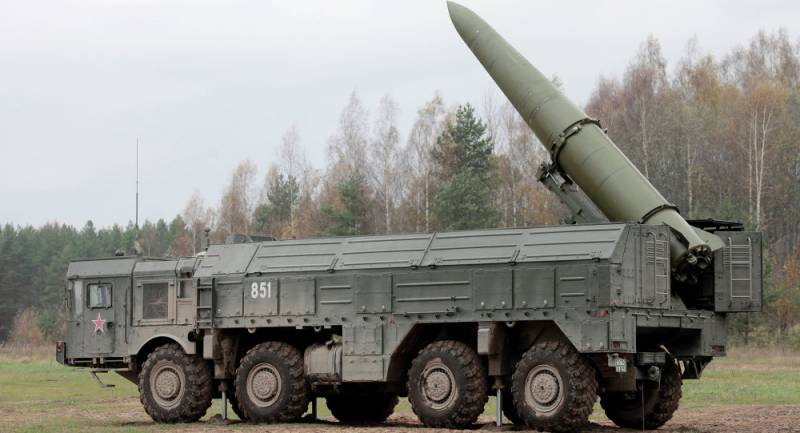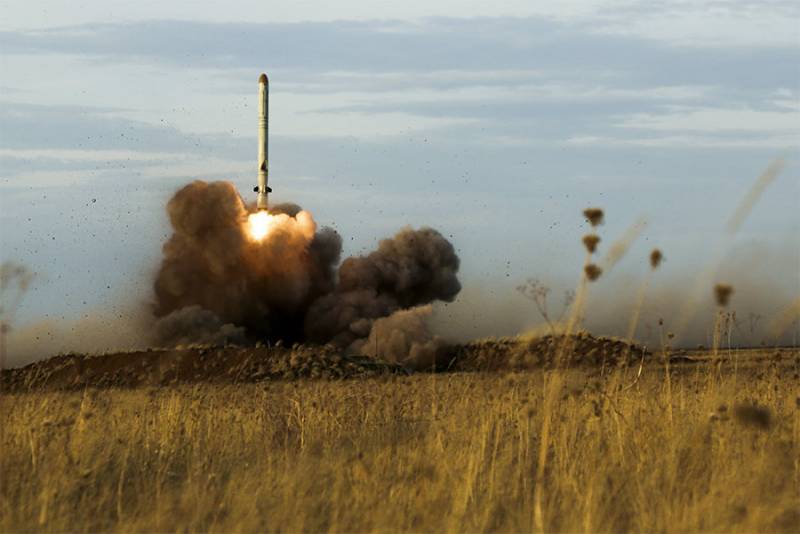Why are NATO afraid of "Iskander"
2 August newspaper published an article with the telling title “Ecco perchè la Nato teme il sistema missilistico russo Iskander”: “That’s why NATO is afraid of the Russian Iskander missile system. In the subtitle, the author of the article, Franco Yakk, notes that a new version of this complex was created to combat the superiority of NATO fleets. Further, he considers other issues related to the deployment and use of Russian missiles.
The author recalls that the missile brigades armed by the Iskanders are stationed in several regions - in the Baikal region, in the Leningrad region, in the southern regions of Russia, as well as in Syria and near Kaliningrad. At the same time, the Kaliningrad region is a key element of Russian protection in the western direction, in the form of an arc extending from the Arctic to the Black Sea. In the course of a hypothetical armed conflict with NATO - since Russia has no bases on the Belarusian territory - the Kaliningrad region will provide access to the northern flank.
In peacetime, the region solves other problems. It turns out to be an advanced post suitable for gathering intelligence information, and is also an important element of the strategic deterrence system. As for the "Iskander", then, based near Kaliningrad, they can hit targets even in Germany.
Kaliningrad - the European fortress of Moscow
Kaliningrad Oblast is a Russian enclave located between Poland and Lithuania. Except for the sea routes, as well as the railway communication, which is under threat at the beginning of a real conflict, the region is separated from Russia. In fact, the region is a giant platform suitable for deploying strategic missiles. According to Moscow, defense facilities near Kaliningrad are a response to the expansion of NATO, as well as the appearance of missile defense facilities in Eastern Europe.
In theory, according to F. Yakk, the Euro-Atlantic missile defense system in the form of Aegis Ashore systems has the ability to intercept Russian missiles in the initial part of the flight, but this will be of little use. The existing missile defense will not be able to cope with the massive blow that should be expected when Russia joins a nuclear war. So far it is capable of fighting only medium-range missiles flying from the Middle East.
The United States and NATO have repeatedly argued that their missile defense system is designed specifically to combat the threat of the Middle East and is not built to confront Russia. At the same time, Moscow continues to express concern and speaks of the risks to the existing system of mutual deterrence. We are talking about NATO defense facilities in Romania and Poland.
F. Yakk believes that the Kaliningrad region will not be able to ensure the advance of a sufficient group. With limited confrontation with the NATO countries, the region will have to act in isolation from the main forces, and its size is insufficient to fully carry out such operations. In the framework of a hypothetical conflict, the region will deal exclusively with self-defense. However, it can accommodate missile systems designed to attack the control structures of European armies. The region is becoming a strategically important element of defense in the western direction.
Multi-purpose missile system "Iskander-M"
The author recalls the technical features of Russian weapons. The 9K270 "Iskander" complex (Stone in the NATO classification) is a high-precision system with a tactical ballistic missile capable of carrying a nuclear weapon. The circular deviation of the missile is only 10 m.
The complex was created by Kolomna KBM and in 2006 year entered service. The new version of the complex includes a single-stage solid-fuel rocket 9М723-1. On the basis of this product, according to F. Yakka, the Dagger rocket was created. The ballistic missile has an inertial navigation system, which is complemented by optical-electronic homing on the final leg of the flight. To evade the enemy's missile defense system and dump false targets, the rocket can perform vigorous maneuvers. According to the Missile Threat project, overloading can reach 30 units when maneuvering. However, Western experts do not confirm such missile capabilities.
The rocket navigation system does not depend on weather conditions. In addition, the flight path does not differ much in height, with the result that the rocket remains in the atmosphere. When flying, the rocket accelerates to M = 2,5. The Iskander-M missile version for the Russian army has a range of up to 480 km.
After the complex arrives at the position, it takes 16 minutes to launch a pair of missiles. If the Iskander is already in position and on duty, the same problem is solved in 4 minutes. At the same time, the interval between launches - for the initial version of the complex intended for the Russian army - can be as little as 50 seconds. Two missiles such a salvo can be aimed at different objects.
Iskander-M is a mobile complex, and therefore it is almost impossible to predict the launch of rockets. The complex is not strategic weapons, but belongs to the operational-tactical class. It is intended to destroy important stationary objects with known coordinates. Missiles can be used against artillery and rocket batteries, airfields, ports, command posts, factories, etc. After launch, the rocket can be re-targeted to another object. One of the objectives of the complex is leveling the logistics advantages of the enemy during the conflict.
It is believed that the missile complex 9K270 has a payload of the order of 700-750 kg and can carry a nuclear warhead of 50 kt. The upgraded version of the Iskander-M2 system, according to F. Yakka, will have higher performance. There is also an export version of the Iskander-E, distinguished by the firing range of the entire 280 km and the use of a missile with an inseparable warhead.
9М768 / Р-500 Iskander-K
The author recalls that the Iskander-M multipurpose complex is usually equipped with a pair of 9М723-1 ballistic missiles. In addition, it is able to use medium-range cruise anti-ship missiles, known as 9М728 or Р-500. The P-500 product was created using the RK-55 Relief, 3М-54 Caliber, X-55 and X-101 / 102 themes. It is capable of hitting a target at a distance of up to 500 km. The first test launch of the Iskander-K missile took place at the end of May 2007.
The P-500 / 9М728 rocket is equipped with an inertial navigation system coupled with a GPS / GLONASS receiver. It carries an 500 kg of combat load, which can be used as a nuclear warhead from 10 to 50 kt. According to known data, the deployment of nuclear missiles P-500 began at the end of last year. The missile is capable of hitting moving targets, and its QUO is just 5 m. The Iskander anti-ship modification is designed to fight NATO cruisers and destroyers and is designed to reduce enemy superiority at sea. To increase combat effectiveness in the final leg of the flight, the rocket accelerates to M = 3 and decreases to the altitude 5-10 m above sea level.
Several years ago, the 9М728 rocket was first used as part of an exercise by Russian troops from the Southern Military District.
9М729 Iskander-K, Novator
According to the United States, not so long ago, two batteries of the Iskander complexes received a promising 9М729 Novator cruise missile (according to the NATO classification - SSC-8). Unlike its predecessors, this product is capable of showing a range of at least 5500 km. In this regard, F. Yakk writes about a possible violation of the existing treaty on medium and short-range missiles.
At the same time, he notes the fighting qualities of the newest rocket. When launched from the Moscow region, the 9М729 product will be able to hit any target in Western Europe. The launch of such missiles from the territory of Siberia allows you to control the entire US West Coast.
Russia's position
Official Moscow has repeatedly expressed concern about the deployment of the Euro-Atlantic missile defense system. Russia believes that the appearance of an anti-missile shield over Europe could disrupt strategic stability in the region. Missile defense is considered not as a means of defense, but as another advanced component of the offensive system. According to the Russian position, the universal vertical launcher Mk 41 used as part of the Aegis Ashore complex violates the terms and conditions of the INF Treaty. Moscow fears that such installations can be used not only for antimissiles, but also with medium-range percussion systems. The launch of cruise missiles from the territory of Poland or Romania allows the likely adversary to hold important objects at gunpoint on Russian territory.
Russia is also concerned about the current American program Prompt Global Strike. It provides for the creation of non-nuclear weapons, characterized by high accuracy, as well as reduced preparation and striking time. It is assumed that to perform an attack on any part of the planet, the “Quick global strike” will spend no more than an hour. The new concept of the United States is based on conventional weapons, but may conflict with the treaty on medium and short-range missiles, prohibiting the creation of systems with a radius from 500 to 5500 km.
What does NATO fear?
Franco Yakk recalls that not only Russia has claims to a foreign partner. The countries of the North Atlantic alliance are also not quite satisfied with the activities of Moscow, they suspect something is wrong and put forward retaliatory accusations.
The United States and NATO also accuse the Russian authorities of violating the INF Treaty signed in 1987. The reason for such charges was the placement of the battery of Iskander complexes armed with the 9М729 / SSC-8 rocket at the Kapustin Yar proving ground. An even more serious concern is the deployment of new missiles on warships. Moscow armed its fleet with medium-range missiles. In addition, the Russian fleet has repeatedly demonstrated this weapon, carrying out strikes against the targets of the Islamists in Syria.
F. Yakk indicates that such attacks demonstrate the capabilities of the new Russian weapons. So, being in the water area of the Caspian Sea, Russian ships with new missiles on board have the opportunity to attack some NATO countries. Such a blow can be carried out with the use of nuclear or conventional weapons.
***
For known and obvious reasons, the majority of foreign publications on Russian arms, its prospects and the impact on the international situation are characterized by an engagement and not the most objective reflection of the situation. Fortunately, the material “Ecco perchè la Nato teme il sistema missilistico russo Iskander” from the Italian newspaper Il Giornale stands out from the crowd and tries to look at the current situation and its components without the traditional stamps of today.
In his article, Franco Yakk examined the technical features of the Iskander missile system and its new modifications, the particular deployment of such weapons in Russian territories, as well as its influence in the international arena. In addition, the Italian author has not forgotten about other rocket weapons. Disputes between states based on mutual accusations did not go unnoticed. As a result, the foreign reader was able to obtain fairly complete information without significant distortions in one direction or another.
The article "Ecco perchè la Nato teme il sistema missilistico russo Iskander":
http://ilgiornale.it/news/mondo/ecco-perch-nato-teme-sistema-missilistico-russo-iskander-1561087.html


Information